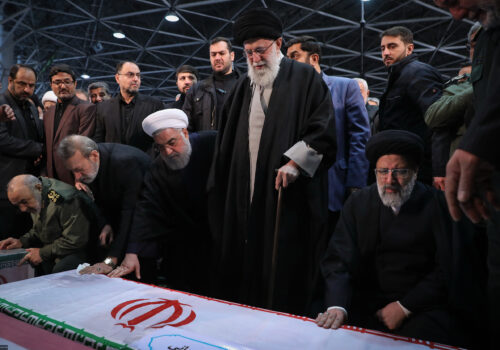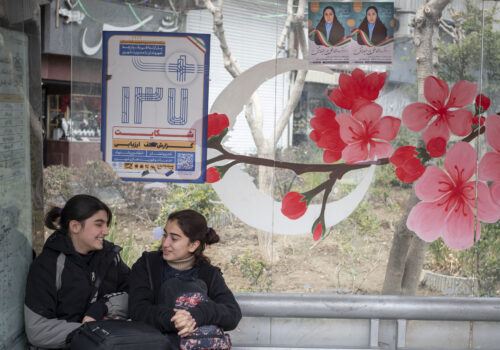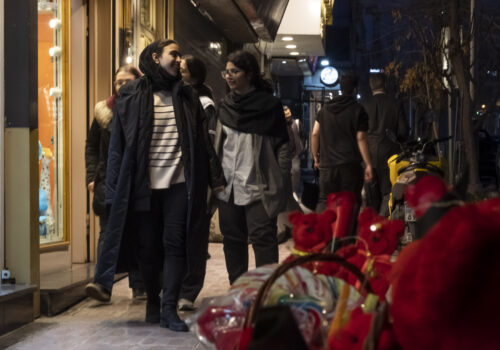Ex-minister Zarif confirms Iran’s reform movement is dead
The Atlantic Council has not been able to independently verify the audio recording highlighted by author or the English translation.
An audio file of a private conversation with Mohammad Javad Zarif, the former foreign minister of the Islamic Republic, surfaced on March 14. The leaked audio, which IranWire published and transcribed, centers around the recent parliamentary and assembly of experts elections on March 1, and sheds much light on the political evolution of the last three decades. It should also inform the US government in its Iran policy moving forward. Crucially, it confirms that, despite accusations by some US policymakers that Iranian moderates were disingenuous, there was, in fact, a sincere reform movement in the 1990s, and now that movement is dead.
The leaked conversation—which is partially erased, and only sixteen minutes of it are available—is between Zarif and a small group of men, but their voices are altered to protect their identities. The career diplomat does most of the talking, but the audience chimes in and comments occasionally. It is the second prominent leak involving Zarif, following a three-hour interview of him in 2021 that was likely a reaction to his being prevented from becoming a presidential candidate that year.
It is uncertain why the perpetrator recorded the meeting. He is likely a secret dissident because he sent the recording to IranWire, a prominent foreign-based and anti-regime website that has been a popular destination for insider leaks.
Contextualizing the publication of the audio recording leads one to believe that this was a private citizen’s act of dissent rather than an insider leak. The substance of the conversation, especially Zarif’s remarks, provides a window into the evolution of the Islamic Republic’s totalitarianism, elevates the reformists of the 1990s, and discredits the moderates of today.
How the reform movement died
In the leaked audio, Zarif is a critic of the reformists of the 1990s. According to the former foreign minister, the reform movement sought “erasure.” Erasure of what is unclear, but the context makes it obvious that he is referring to either the role of Supreme Leader Ayatollah Ali Khamenei or the entirety of the system. He claims that the movement sought constitutional reform of the clerical establishment. In his view, it is evident that the threat to the political establishment posed by the reformists would lead to the solidification of Khamenei’s camp’s power; that is, the hardliners.
The reformist movement kicked off in 1997 when reformist Mohammad Khatami became president with 69 percent of the vote. However, after eight years as head of state, Khamenei was still not the biggest political force in Iran’s informal politics. President Ali Akbar Hashemi Rafsanjani, whom Khatami succeeded, was the lead character in the show. In his memoirs, Rafsanjani claimed that he ensured that there would be no cheating, and Khamenei lacked the power to override Rafsanjani’s will. This was the first triumph for reformers.
Reformists sought to curb the supreme leader’s power. The revolution had succeeded in 1979 by falsely promising that the supreme leader would simply be a moral guide residing in Qom, not an assertive politician in Tehran. In the 1990s, the revolution was only in its second decade of life, and many reformists remembered this promise and sought to realize it. Khamenei, chosen for his perceived ineptitude at the time, did not appear to be an intimidating bulwark against liberalization like the founder of the Islamic Republic, Ayatollah Ruhollah Khomeini. Rather, people looked at Rafsanjani as the real obstacle to change.
Furthermore, many reformists were personally loyal to Khomeini and accepted his absolute power, but there was no such personal allegiance to Khamenei. Rafsanjani’s departure from the presidency was an opportunity to change the regime’s structure, beginning with reducing the position of the supreme leader to what had been promised in 1979. This meant clipping Khamenei’s wings.
At the time, the reformist movement energized the youth. Demands for change grew in intensity and climaxed in the summer of 1999 at the campus of Tehran University. Known as the 1999 student uprising, this was the first serious, popular challenge to the clerical establishment and Khamenei’s power as supreme leader, and it resulted in violent suppression and mass arrests. In response, Zarif claims, Khamenei began appearing in public wearing keffiyeh to solidify support among the regime’s base. As a personal anecdote, Zarif mentions that the official portraits of Khamenei in government offices up until that point showed the leader without a kaffiyeh, but authorities replaced them with new portraits showing him with the scarf after the 1999 uprising. Khamenei began wearing it as a signal that he was also resisting the reformists, adding an accusation that they were agents of “the soft war,” his term for the United States’ ideological appeal. This began a project to elevate Khamenei to fill the charismatic and ideological leadership vacuum that Khomeini had left.
There was also an electoral challenge. Months after the protests, with Khamenei still too weak to force his will, reformists dominated the legislature. The Second of Khordad Front—the name reflects the date of Khatami’s victory and shows the movement’s high morale—won 222 out of the 290 seats in parliament. However, most of the bills that the sixth parliament passed were struck down by the twelve-member Guardian Council—a vetting body appointed by Khamenei that, de jure, decides who makes electoral ballots and whether a bill passed by the parliament is consistent with the constitution and Islamic laws. But through budgeting and public statements, the reformists were making small inroads toward change.
SIGN UP TO THIS WEEK IN THE MIDEAST
Khatami would win reelection in 2001, but most reformist parliamentary candidates were disqualified by the Guardian Council, creating space for Khamenei loyalists to make their comeback. Years later, in 2005, Mahmoud Ahmadinejad, a mostly unknown hardline candidate favored by the security forces, won the presidency amid suspicions of fraud. During Khatami’s eight years, the supreme leader created a parallel security apparatus within the official security organizations. A new secret police division in the Islamic Revolutionary Guard Corps (IRGC), known as the parallel intelligence agency, sidelined the intelligence ministry. Khamenei also expanded counterintelligence divisions within the armed forces to identify loyalists and doubters. In Iran’s informal government culture, all these offices were directly responsible to him, not to their immediate supervisors. After Ahmadinejad became president, he added to the IRGC’s power and budget at the cost of Iran’s electoral institutions.
As Zarif argues, these actions by Khamenei were a reaction to the reformists’ threats to his power. Another possible explanation is that Khamenei’s solidifying power would happen regardless of circumstances, consistent with autocratic conduct in history. Using his legal powers, and with his rival Rafsanjani out of the way, Khamenei was always going to fill the military and civilian establishments with his loyalists and purge the rest. Nonetheless, if the career diplomat’s story is to be believed, the reform movement was sincere in its intentions, and it would be a mistake to dismiss it as dishonest or just for show. Unfortunately, sincere or not, it is dead—especially after the 2009 post-election protests known as the Green Movement.
In 2009, reformists bid for a comeback, but systemic fraud led to the reelection of Ahmadinejad. Nearly a year of mass protests followed, marking the first existential crisis for the Islamic Republic since the end of the eight-year Iran-Iraq War (1980–1988). The regime succeeded in putting down the protests, but the lesson it learned was that such protests could never happen again. The rest of Zarif’s story confirms this.
The Green Movement provided a golden opportunity to eliminate the honest reformists. Its leaders, Mir Hossein Moussavi and Mehdi Karoubi, have been under house arrest since 2011 and forgotten. Khatami, too, has been banned from public appearances and even boycotted the March 1 elections. His brother, Mohammad Reza, known to have been more forceful in seeking change, was the first to be arrested in 2009 and is entirely sidelined. His wife, the granddaughter of Khomeini, who is known for her socially liberal views within the Islamic Republic context, has experienced a similar fate. Military commanders who expressed sympathies with the public during the Green Movement were also eliminated via assassination, forced retirement, or purges—some others voluntarily retired in disgust. What was left was a homogeneous leadership dedicated to preserving the system in its current form.
Zarif on elections
As mentioned above, Iran’s ballot qualifications are constitutionally determined by the Guardian Council. In the audio leak, Zarif mentions that, despite the formal process, two men outside the council approve the final list. They are Ali Jafari, the former commander in chief of the IRGC, and Hossein Taeb, the former IRGC intelligence chief and the former commander of its student militia wing, the Basij. They are the most powerful men in the regime’s election schemes.
The regime has walked away from fraud to avoid repeating another 2009 scenario. Instead, Jafari and Taeb fix the list of candidates who qualify for the ballot and disqualify reformists who could win. On one occasion, Zarif admits that an intelligence organization, likely IRGC’s parallel intelligence agency, summoned him to explain whether he would register as a candidate, and added later that he would have been disqualified if he had. In sum, it is already a draconian process in which Khamenei has enormous influence, and an informal parallel scheme still circumvents the constitution mandates.
Zarif concludes that the regime ensures that the reformists and centrists who make the ballot are too uncharismatic or unknown to win—or even if they win, too slavish to pose a threat to the system.
There is a logical sequence in Zarif’s analysis. The reform movement was sincere, and it was cracked down on because it challenged the Islamic Republic and Khamenei. Therefore, the remaining reformists and moderates are either disingenuous or too weak to effect change. It is possible that the United States could have used its resources to help the movement succeed in 2009, but its leaders declined the offer, fearing that such help would be a license for the regime to crack down on protesters. They were wrong to decline the offer, as Khamenei and the security services killed the movement. Its leaders and those sympathetic to it have been subjected to house arrest, political purge, and assassination. Given this context, US policymakers should accept that the regime has become reform-proof, and that the only moderates and centrists who have been elevated to senior positions since 2009 have executed the policies of the hardliners. This will remain the case for the foreseeable future.
Shay Khatiri is the vice president of development and a senior fellow at the Yorktown Institute.
Further reading
Wed, Mar 13, 2024
For meaningful change in Iran, Khamenei has got to go
IranSource By
The supreme leader's death will provide people inside Iran and the diaspora with a historic chance to make a foray into fundamental change in the country.
Wed, Feb 28, 2024
March 1 is the upcoming Iranian elections. The terrain looks more divided than ever.
IranSource By
With widespread disillusionment with the Islamic Republic and its unrepresentative institutions, few people care to take part in these elections.
Fri, Feb 16, 2024
Iran is socially engineering mass depression to suppress dissent
IranSource By
The Islamic Republic has worked tirelessly to strategize and doctrinize control of Iranians’ minds and bodies. But it hasn't always been successful.
Image: Iran's Foreign Minister Mohammad Javad Zarif waits to meet with the acting head of the U.N. nuclear watchdog (IAEA), Cornel Feruta, in Tehran, Iran September 8, 2019. Nazanin Tabatabaee/WANA (West Asia News Agency) via REUTERS


